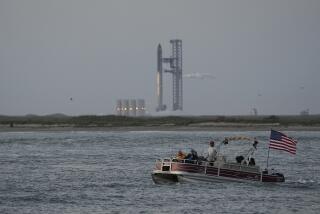NASA’s flying saucer takes a supersonic flight, and you can tag along
By the time NASA’s flying saucer splashed down in the Pacific in June, the engineers who designed it already knew their experiment had been a huge success. From the control tower at Kauai’s Pacific Missile Range Facility, they had watched the Low-Density Supersonic Decelerator — a device intended to enable bigger and better missions to Mars — soar through a series of critical tests as it arced high in the atmosphere above Hawaii.
The only hitch came at the end of the flight, when the LDSD’s parachute failed to inflate. This was the final step in a carefully choreographed sequence of events designed to simulate here on Earth what it’s like to land millions of miles away on Mars.
Now, scientists at the Jet Propulsion Laboratory have had a chance to pore through the gigabytes of data collected during the flight. On Friday, they gave the public a first glimpse of how the supersonic voyage through Earth’s atmosphere looked from the vehicle’s point of view.
This glimpse was quite literal: NASA released video footage captured by cameras mounted on board as it blazed through the sky.
Speaking from JPL’s Von Karman Auditorium in La Cañada Flintridge, project manager Mark Adler said that these videos will be of great help to his team as they continue to analyze how the test went and how to improve the LDSD’s performance for future tests – and, eventually, missions to Mars.
“If a picture is worth a thousand words, then a video is worth about a million,” Adler said.
The cameras aboard the saucer-shaped vehicle allowed the scientists to watch the 34-million-cubic-foot balloon inflate as it climbed through Earth’s atmosphere, hoisting the LDSD behind it.
The cameras captured LDSD’s thrusters as they flared to life after the balloon dropped the vehicle 120,000 feet above Hawaii, causing it to spin like a top to enhance its stability.
A rocket engine then launched the vehicle to a height of 190,000 feet and a speed of Mach 4.3 — more than four times the speed of sound — in just 71 seconds.
At this point, Adler said, the NASA team had already met the main objectives of the experiment: to demonstrate that they could successfully create the conditions a spacecraft would face as it came hurtling toward Mars from interplanetary space.
But then they had to slow the LDSD down again and bring it safely back to Earth’s surface, the ultimate purpose it will serve on Mars.
The vehicle brakes in three steps. First, it inflates a Supersonic Inflatable Aerodynamic Decelerator, or SIAD — a giant donut that puffs up around the device and increases its drag.
The video footage taken during the flight shows this worked exquisitely well. In 0.3 seconds, the SIAD inflated to its full volume and easily withstood the violent forces incurred while tearing through the atmosphere at supersonic speeds. The 20-foot airbag deformed by less than an eighth of an inch, said Ian Clark, the project’s principal investigator.
You can see all this in a “high-speed panoramic selfie” taken by LDSD’s camera, Clark said. (“Look for this on Instagram later,” he added.)
After the SIAD successfully slowed the vehicle to a leisurely Mach 2.5, the next phase of deceleration began with the deployment of the “ballute,” a combination parachute and balloon that engineers installed to help deploy the massive supersonic chute that would ultimately slow the vehicle to landing speeds.
The ballute also performed seamlessly, despite haunting Clark’s dreams in the weeks leading up to the test. Designing and implementing the ballute was just one of the many hurdles scientists faced in building and figuring out how to test the LDSD’s massive components, which are too large for any wind tunnel on Earth.
However, the 100-foot wide parachute did not behave as the engineers had hoped. It began to fray and tear as soon as it unfurled behind the 7,000-pound vehicle plummeting to Earth. Clark and his colleagues will continue to scrutinize the video footage for clues about what went wrong and why.
“We’ve learned a lot already, like we need to learn more about supersonic parachutes,” Clark said.
For the second round of tests next summer, Clark said they are already redesigning the parachutes to be rounder and stronger. They will also try to better control how the parachute opens in the turbulent chaos created by the vehicle’s descent.
Without the parachute’s help, the LDSD plummeted into the ocean on June 28, and the “supersonic space boat,” as Adler called it, was retrieved by Navy divers and tugboats. The scientists harvested data from all the sensors that recorded the vehicle’s flight and the images captured by its cameras.
They recovered the shredded parachute too, which looked “like a big jellyfish,” Adler said. Studying its tattered fabric will further help the team build better versions for the future.
Overall, the effort was really a test of a test — proof that the scientists could find Mars-like conditions on Earth without having to build an impossibly large wind tunnel. Scientists hadn’t planned to test the decelerators this year, so learning how the SIAD, the ballute and the parachute performed was a bonus, Clark said, even if the parachute had problems.
The experiment was also a success for NASA’s relatively new Space Technology Mission Directorate, created to develop technologies for future projects before they are needed.
“We are creating new knowledge, we are developing new capabilities, and we are demonstrating new technologies,” said Jeff Sheehy, a senior technologist of the directorate based in Washington, D.C. “That’s what we are all about, and this project has been doing all of those things in a very big way.”
For all things science, follow me @ScienceJulia







